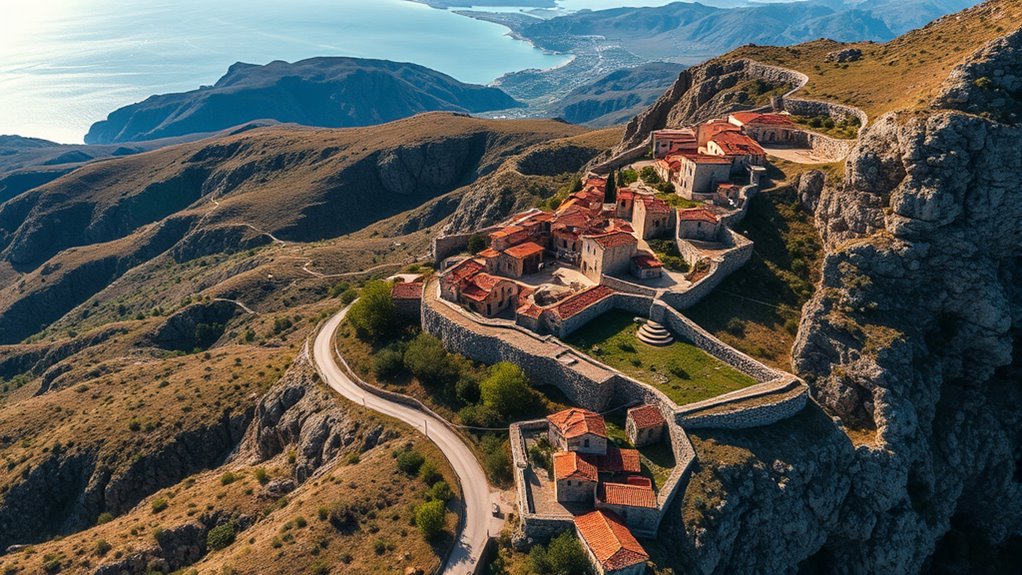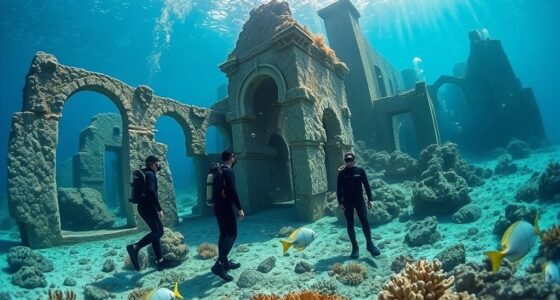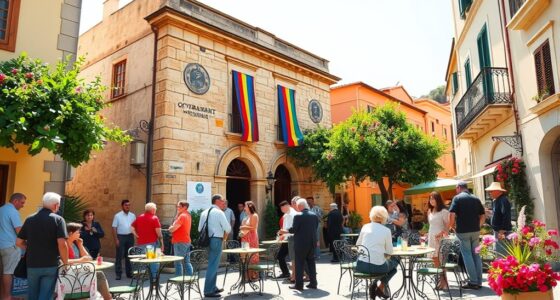Sardinian migration patterns over centuries show a history of movement driven by environmental challenges, economic struggles, and political shifts. Early migrations occurred via sea routes, with many leaving due to land scarcity and limited opportunities. In the 20th century, industrialization and social changes prompted large-scale emigration to Italy, Europe, and the Americas. Today, demographic decline and global migration trends continue to shape Sardinia’s population, offering a fascinating view of its enduring mobility—if you explore further, you’ll uncover even more details.
Key Takeaways
- Sardinia’s earliest migrations involved prehistoric sea crossings and inland movements during the Nuragic era.
- Phoenician, Carthaginian, and Roman maritime routes facilitated coastal trade and migration over centuries.
- Post-19th and 20th centuries saw significant emigration due to economic hardship, land scarcity, and industrial decline.
- Industrialization in the 1960s prompted internal migration from rural areas to urban centers and northern Italy.
- Contemporary migration includes international movement to European countries and diaspora communities worldwide.
Historical Waves of Sardinian Migration
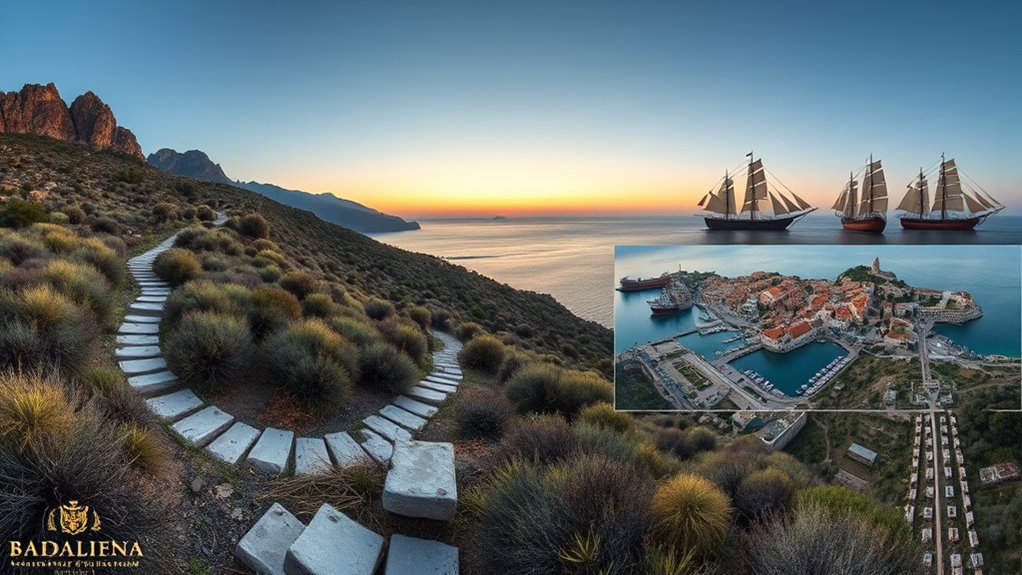
The historical waves of Sardinian migration reflect a long history of people moving to and from the island, shaping its unique cultural landscape. You can trace early settlements back over 13,000 years, with prehistoric humans leaving archaeological evidence. During the Nuragic civilization (10th–8th centuries B.C.), Sardinia saw the construction of around 8,000 nuraghes, showcasing an advanced indigenous culture. Phoenician traders arrived between the 10th and 8th centuries B.C., blending into coastal communities and introducing new technologies. Later, Carthage and Rome dominated, influencing governance and culture. Throughout these periods, Sardinians maintained genetic links to early European farmers and hunter-gatherers. Population movements during Roman, medieval, and early modern times added layers to the island’s demographics, laying the groundwork for future migration trends. Genetic continuity across centuries also played a significant role in preserving many aspects of Sardinian identity despite external influences. Additionally, the ongoing interactions with various Mediterranean civilizations contributed to the cultural diversity evident on the island today.
Causes and Drivers of Emigration
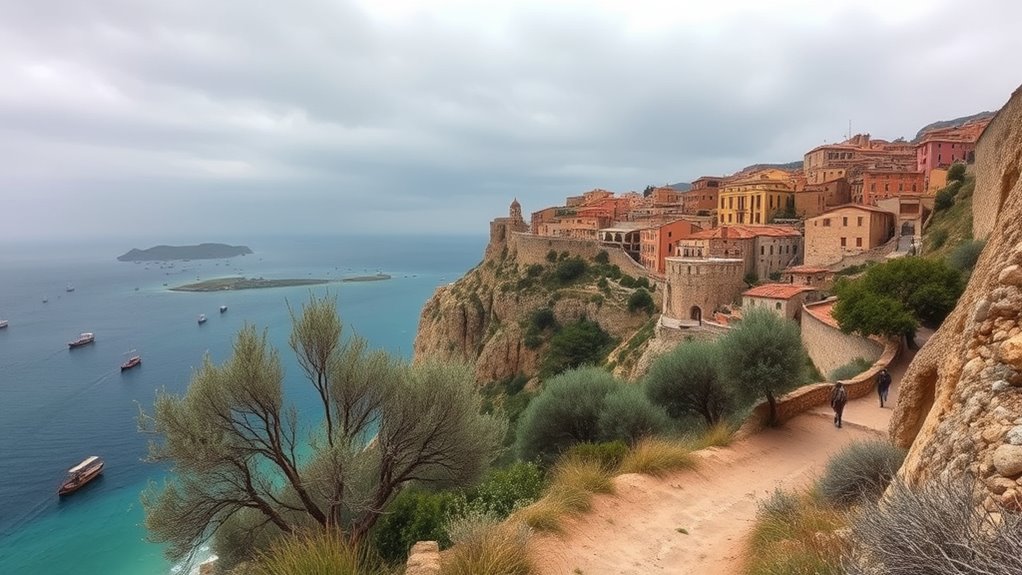
You can’t ignore how economic hardship pushed many Sardinians to leave, especially as land scarcity and limited jobs made rural life unsustainable. Post-war industrial growth was slow and uneven, offering few opportunities beyond agriculture. As a result, many sought better prospects elsewhere, fueling the island’s migration waves. Additionally, the availability of eco-friendly living options, such as relocating to urban areas with better infrastructure and employment opportunities, further contributed to migration trends.
Economic Hardship Triggers
Economic hardships in Sardinia have been a primary driver of emigration, fueled by the decline of traditional sectors like agro-pastoralism and mining. You’ve seen how dissatisfaction with rural life pushed many, especially in Nuoro, to seek better opportunities elsewhere. The collapse of mining industries left many workers without jobs, forcing them to emigrate to find work abroad. Rural areas struggled with slow agricultural modernization and landownership systems resistant to change, limiting local economic growth. Post-World War II, underdevelopment and inadequate infrastructure worsened living conditions, prompting large waves of departure. Family and social constraints also played a role, with traditional patriarchal structures discouraging local innovation. As opportunities dwindled, leaving Sardinia became a necessary step toward economic survival and upward mobility. Economic decline and lack of modernization also contributed significantly to the push for emigration. Additionally, the limited adoption of technological advancements hindered economic development and further motivated emigration.
Limited Local Opportunities
Limited local opportunities have substantially fueled emigration from Sardinia. Land scarcity, tiny plots from generations of subdivision, and a sharecropping system discouraged investments in agriculture, limiting growth. The terrain offers little fertile land, and pastoralism couldn’t absorb all rural workers. Population growth from improved health increased competition for scarce land and jobs, pushing many to leave. Infrastructure deficits and a lack of industrial diversification kept young people seeking better prospects elsewhere. Sardinia’s peripheral status and political marginalization compounded these issues, with limited services and connectivity reducing local opportunities. Limited economic development further constrained local prospects, reinforcing the push factors driving Sardinian migration. The table below illustrates key factors:
| Causes | Effects |
|---|---|
| Land subdivision | Reduced farming sustainability |
| Slow land reforms | Few viable agricultural options |
| Population growth | Elevated competition for jobs/labor |
| Industrial stagnation | Fewer local employment opportunities |
| Infrastructure gaps | Limited mobility and services |
Post-War Industrialization
After World War II, Sardinia experienced a wave of industrialization driven by government-led initiatives aimed at rebuilding and modernizing the region. In the 1960s, the *Piani di Rinascita* focused on infrastructure, creating industrial complexes like oil refineries, petrochemical plants, dams, roads, and reforestation projects. Industrial parks near ports and airports, managed by 16 consortiums, boosted connectivity and growth. Public investments and credit from state-owned enterprises expanded manufacturing, transforming thousands of ex-farmers into industrial workers. The region also saw increased migration from other parts of Italy, seeking employment opportunities in new industries. However, Sardinia’s economy also became heavily influenced by military bases, limiting land for civil use and shaping demographics. The 1973 oil crisis caused layoffs in petrochemical industries, fueling emigration. Overall, industrialization opened opportunities but also created economic vulnerabilities, prompting many to seek stability elsewhere.
Migration Routes and Destination Countries
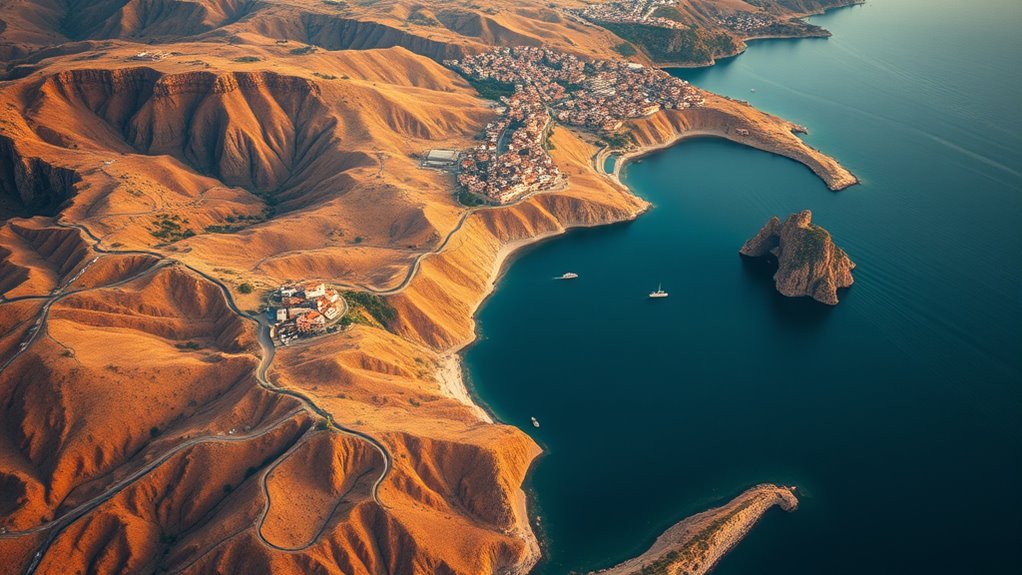
You can see that Sardinians mainly migrate to Italy’s northern and central regions, as well as other European countries, seeking better opportunities. Migration routes often follow established maritime paths from Sardinia’s ports, connecting to major urban centers. These movements tend to be more common in urban areas, though rural communities also see migration driven by economic needs. Historical migration patterns reveal that these routes have remained relatively consistent over centuries, influenced by political, economic, and social changes in both Sardinia and destination countries. Additionally, migration routes are often shaped by geographic features and transportation infrastructure that facilitate movement.
Main Destination Countries
Sardinian migrants have historically gravitated toward several key destination countries across Europe, the Americas, and beyond, driven by economic opportunities and migration networks. In Europe, Germany hosts around 631,243 Italians, including Sardinians, while Switzerland holds about 520,713 Italians due to its proximity and economic ties. France, especially border regions, attracts Sardinian migrants linked to tourism and labor. The UK also sees Sardinian migration, mainly for seasonal work and economic reasons. In the Americas, Argentina’s large Italian community includes many Sardinian descendants, with the US and Brazil also significant destinations. South American countries like Uruguay and Canada attract Sardinian migrants seeking employment and education. Smaller destinations include Oceania, Africa, and Asia, where Sardinians pursue new opportunities within global migration trends.
Migration Route Patterns
Migration routes from Sardinia have historically followed both maritime and overland paths that connect the island to key destination regions. In ancient times, early farmers crossed the Mediterranean, establishing coastal settlements, while later Phoenicians and Carthaginians used maritime routes to build trading cities along the coast. During the Roman period, migrants mainly arrived by sea at coastal ports, with limited inland movement. In the 19th and early 20th centuries, many Sardinians emigrated via Mediterranean routes to North Africa, especially French colonies. Post-World War II, internal and European migration increased, often through overland routes into mainland Italy and beyond. The table below summarizes these migration patterns:
| Era | Main Routes | Destination Regions |
|---|---|---|
| Prehistoric | Mediterranean crossing | Coastal Sardinia |
| Phoenician/Carthaginian | Maritime coastal routes | North Africa, Spain |
| Roman | Coastal ports | Italy, Mediterranean |
| 19th/20th Century | Mediterranean sea, overland | North Africa, France |
| Post-WWII | Overland, European corridors | Mainland Italy, Europe |
Sardinian migration patterns were also influenced by economic opportunities, prompting many to seek work abroad or in industrial centers, contributing to the diverse origins of Sardinian communities today.
Urban Vs Rural Destinations
Why have urban centers historically attracted more migrants than rural areas? Urban areas offered better economic opportunities, with industries and jobs that rural Sardinia couldn’t match. You’d find cities like Turin and Milan appealing because they promised stability and income, unlike the limited resources in rural regions. Migrants sought these cities to escape economic hardship and maintain their livelihoods. Over time, this trend resulted in rapid urbanization and depopulation of rural areas, which struggled to preserve traditional culture amid decline. Internationally, many Sardinians moved to countries like France and Germany, attracted by better economic prospects. Research shows that local impacts of climate change, such as flooding and coastal erosion, have also influenced migration patterns. While rural areas face ecological and demographic challenges, cities continue drawing migrants for work, education, and social integration, shaping Sardinia’s migration landscape over centuries. Additionally, urbanization trends have been driven by broader societal shifts, including technological advancements and changing employment structures, which further reinforce migration toward city centers.
Social and Cultural Consequences of Migration
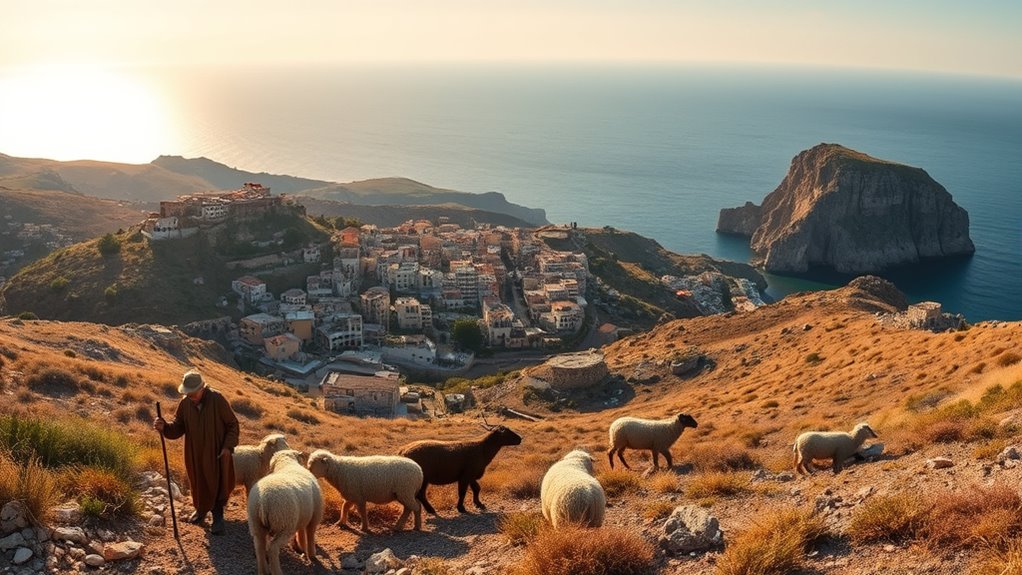
Have you ever wondered how movement across borders shapes a community’s identity and social fabric? When Sardinians migrate, they carry their culture abroad, creating a trans-local identity that extends beyond the island. This diaspora sustains social ties, kinship networks, and cultural practices, influencing perceptions of Sardinian-ness both locally and worldwide. Long-term migration fosters a sense of belonging that’s not confined to Sardinia itself. Understanding the AI Bifurcation can shed light on how such cultural identities evolve and adapt in a rapidly changing world.
Genetic and Archaeological Insights Into Sardinian Origins
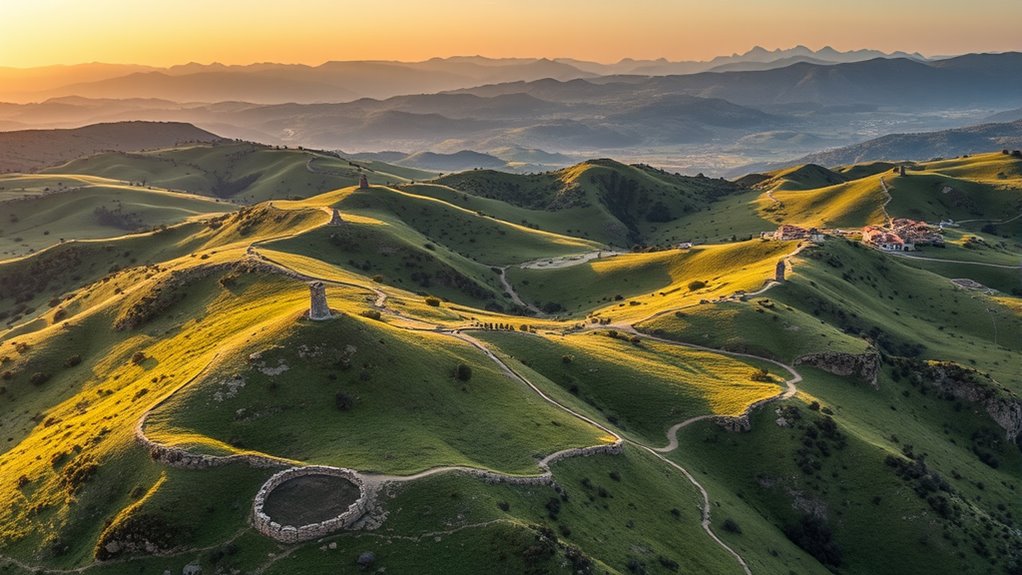
Sardinia’s genetic and archaeological record reveals a deep-rooted history that traces back to the Neolithic period, shaping the island’s unique identity. About 62.5% of your genome derives from early Neolithic farmers, who settled there as a Mediterranean refuge, with genetic continuity from Middle Neolithic into the Bronze Age. While mainland Europe saw significant migrations, Sardinians remained genetically stable, sharing ancient ties with populations like the Basques. Whole-genome studies uncover regional differences within Sardinia, especially between isolated inland and coastal areas, influenced by sex-biased demographic processes. Starting in the Iron Age, contact with Phoenicians, Punics, and Romans introduced new genes, yet the Neolithic core persists. Genetic similarities with ancient mainland European populations further support the idea of Sardinia as a long-standing genetic refuge. Archaeological findings from over 6,000 years offer essential insights into this genetic continuity and resilience, highlighting the island’s role as a genetic refuge in Europe.
The Sardinian Diaspora and Its Impact
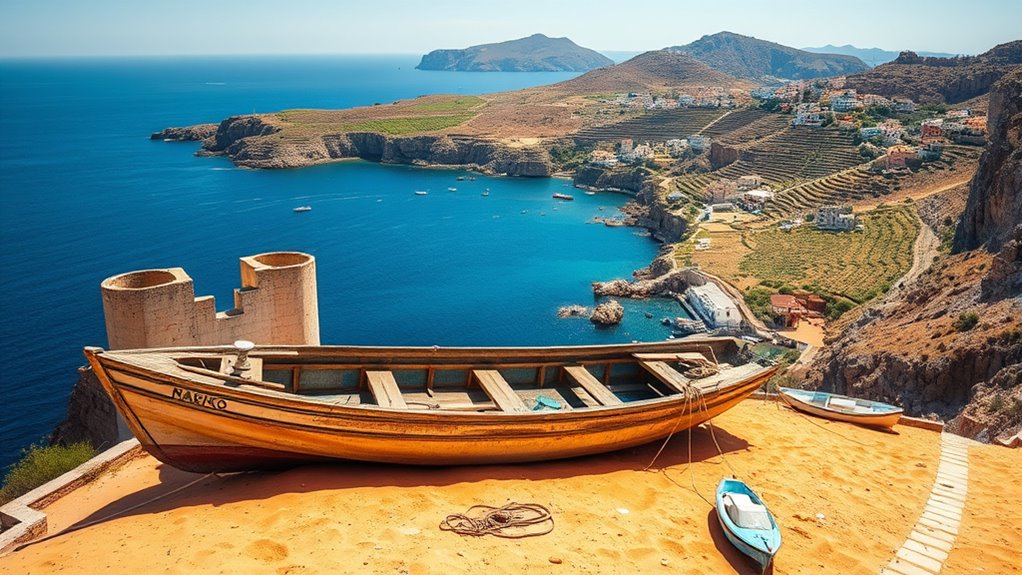
The Sardinian diaspora has played a significant role in shaping the island’s cultural and social landscape over centuries. When you migrate, you often keep strong ties to Sardinia, preserving unique traditions, language, and identity. Many Sardinians settle in Italian cities like Rome and Milan or abroad, forming close-knit communities that maintain their cultural practices. These migrant stories span generations, reflecting a consistent flow of people seeking better opportunities while holding onto their roots. The diaspora influences Sardinia’s economy through remittances and investments, helping the island develop. At the same time, migrants adapt to new environments, balancing integration with cultural preservation. This ongoing connection between Sardinia and its dispersed communities continues to shape the island’s identity and global presence. Additionally, the migration patterns over centuries have contributed to a diverse and resilient cultural mosaic on the island.
Contemporary Migration Trends and Future Challenges
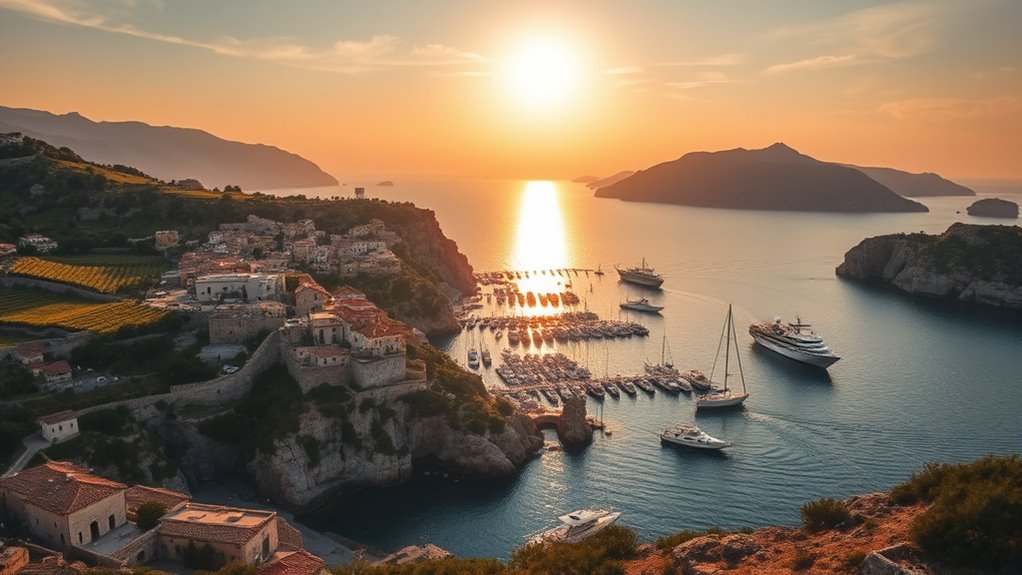
Recent migration patterns in Sardinia reveal a complex landscape shaped by demographic shifts and economic factors. The region has experienced a significant population decline, losing 88,306 residents over the past eight years, with 8,314 leaving in just one year. Low birth rates and an aging population further challenge its future, increasing pressure on healthcare and social services. Immigration mainly comes from Romania, Senegal, and Morocco, with Romania being the largest group. Economic factors like unemployment, reliance on tourism, and export challenges influence migration decisions. By 2050, Sardinia’s population could drop by 21%, worsening rural depopulation and economic sustainability. Addressing these issues requires policies focused on boosting birth rates, encouraging local development, and managing migration to make certain of the region’s future stability. Sardinia’s population decline underscores the urgency for comprehensive regional strategies to reverse these trends and promote sustainable growth. Additionally, remote work has the potential to mitigate some economic challenges by enabling more flexible employment opportunities for residents.
Frequently Asked Questions
How Did Sardinian Migration Influence the Island’s Local Dialects and Linguistic Landscape?
You see, migration has a big impact on Sardinian dialects and the island’s linguistic landscape. When people move to cities, they tend to adopt Italian, which weakens local dialects. Migration also brings external influences, like media and new languages, that change vocabulary and pronunciation. Over time, this pushes Sardinian dialects toward decline, especially among younger generations, altering the island’s linguistic diversity and cultural identity.
What Role Did Sardinian Migration Play in Shaping Regional Political Identities?
You see, Sardinian migration played a crucial role in shaping regional political identities. As you move abroad or within Italy, you carry your cultural and nationalist sentiments, helping to spread Sardinian ideas and maintain a sense of identity. These migrant communities stay connected to the island, fueling political activism and influencing local movements. Migration consequently reinforces Sardinian nationalism, shaping political debates and fostering a strong regional identity both on and off the island.
Are There Notable Differences in Migration Patterns Between Northern and Southern Sardinia?
You might find it fascinating that northern Sardinia has more genetic influence from mainland Europe, while southern Sardinia shows traces of North African gene flow. You notice that southern coastal areas were more open to maritime migration and external contact, especially during Phoenician times. Meanwhile, the mountains and geography in the north kept populations more isolated, leading to distinct migration and genetic patterns between the regions.
How Has Sardinian Migration Affected Traditional Craft and Artisanal Industries?
Migration has profoundly impacted Sardinian crafts and artisanal industries. As you move from rural inland to urban areas, traditional skills often fade as younger generations leave, but migrant communities abroad preserve and revive these crafts. Migration also introduces new materials and techniques, creating hybrid art forms. Additionally, tourism and economic shifts have transformed craft production, encouraging commercialization and adaptation, which helps sustain Sardinian artisanal heritage despite demographic changes.
What Are the Environmental Impacts of Historical and Modern Sardinian Migration?
You see, migration’s many movements markedly modify land use and environmental health. Historically, as people migrated, they transformed terrains, turning scrublands into fields, which sometimes caused soil erosion and biodiversity shifts. Today, urban influxes heighten habitat loss, coastal erosion, and resource strain, complicating climate challenges. These continuous changes demand careful consideration, as migration’s migration-mad impacts mold Sardinia’s landscapes, livelihoods, and ecological equilibrium over centuries.
Conclusion
As you trace Sardinia’s migration journey, you see a tapestry woven with threads of hope, resilience, and change. Each wave of movement writes a new chapter in its story, shaping not just the island but the world beyond. Like a river carving new paths, Sardinian migration flows through time, leaving echoes in distant lands. Embrace this voyage’s rich history, for it reminds us that migration is the heartbeat of cultural evolution and interconnected destinies.
